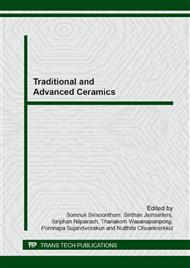[1]
C. Klingshirn, The Luminescence of ZnO under High One- and Two-Quantum Excitation, Phys. Stat. Sol. B 71 (1975) 547-556.
DOI: 10.1002/pssb.2220710216
Google Scholar
[2]
D. C. Look, B. Claflin, P-type doping and devices based on ZnO, Phys. Stat. Sol. (b) 241 (2004) 624-630.
DOI: 10.1002/pssb.200304271
Google Scholar
[3]
A.B. Djurisic, Y. Chan, E.H. Li, Mater, Progress in the room-temperature optical function of semiconductors, Mater Sci. Eng. R38 (2002) 237-293.
Google Scholar
[4]
K. Ellmer, Resistivity of polycrystalline zinc oxide films : current status and physical limit, J. Phys. D: Appl. Phys. 34 (2001) 3097-3108.
DOI: 10.1088/0022-3727/34/21/301
Google Scholar
[5]
Y.F. Chen, D. Bagnall, Synthesis ZnO nanostructure, Mater. Sci. Eng. 75B, 190 (2000) 253.
Google Scholar
[6]
D.C. Look, Recent advances in ZnO materials and devices, Mater. Sci. Eng. B 80 : (2001) 383-387.
Google Scholar
[7]
W. I. Park, G. C. Yi, S. J. Pennycook, Applications of highly ordered wheel like structured ZnO nanorods, Adv. Mater. 14 (2002) 1841-1843.
Google Scholar
[8]
S. Chakrabarti, S. Chaudhuri, Persistent photoconductivity studies in nanostructured, Mater. Chem. Phys. 87 (2004) 196–200.
Google Scholar
[9]
F. Liu, P. Cao, H. Zhang, C. Shen, Z. Wang, J. Cryst. Growth 274 (2005) 126–131.
Google Scholar
[10]
S. Noothongkaew, S. Pukird, W. Sukkabot, Ki-Seok An, Zinc Oxide Nanostructures Synthesized by Thermal Oxidation of Zinc Powder on Si Substrate, Applied Mechanics and Materials Vol. 328 (2013) 710-714.
DOI: 10.4028/www.scientific.net/amm.328.710
Google Scholar
[11]
Y. J. Hong, J. Yoo, Y. -J. Kim, C-H. Lee, and G. -C. Yi, Adv. Mater. 20 (2008) 1.
Google Scholar
[12]
J. Maeng, G. Jo, M. Choe, W. Park, M. -Ki Kwon, S. -Ju Park and T. Lee, Structural and photoluminescence characterization of ZnO nanowalls grown by metal organic chemical vapor deposition, J. of Thin Solid Films, 518 (2009) 865-869.
DOI: 10.1016/j.tsf.2009.07.105
Google Scholar
[13]
Lee Chul- Ho, Kim Yong-Jin and Lee Joohyung, Nanotechnology 22 (2011) 055205.
Google Scholar
[14]
L. Min Yu, X. Hui Fan, J. Yi Shui and W. Yan, Research on the growth of ZnO nanowall by soft-solution route, Material Letters 68 (2012) 423-425.
DOI: 10.1016/j.matlet.2011.11.027
Google Scholar
[15]
B. Megan M, Lu Ming-Yen and Lim Sung Keun, J. of Phys Chem Lett. 2 (2011) 1940-(1945).
Google Scholar
[16]
Su SC, Lu Ym and Zhang ZZ, Structural optical and hydrogenation properties of ZnO nanowall networks grown on a Si (111) substrate by plasma-assisted molecular beam epitaxy, Physica B 403 (2008) 2590-2593.
DOI: 10.1016/j.physb.2008.01.040
Google Scholar
[17]
Z. Yin, N. Chen, R. Dai, L. Liu, X. Zhang, X. Wang, J. Wu and C. Chai, On the formation of well-aligned ZnO nanowall networks by catalyst-free thermal evaporation method, J. of Crystal Growth 305 (2007) 296-301.
DOI: 10.1016/j.jcrysgro.2007.04.043
Google Scholar
[18]
W. Tan, K. Radul, and Z. Lockman, Oxidation of etched Zn foil for the formation of ZnO nanostructure, J. of Alloys and Compounds 509 (2011) 6806-11.
DOI: 10.1016/j.jallcom.2011.03.055
Google Scholar
[19]
Z. Wu, L. Qin and Q. Pan, Fabrication and electrochemical behavior of flower-like ZnO-CoO-C nanowall arrays as anodes for lithium-ion batteries, J. of Alloys and Compounds 509 (2011) 9207-9213.
DOI: 10.1016/j.jallcom.2011.06.114
Google Scholar
[20]
X. Yan, X. Tong, J. Wang, M. Zhang and L. Liang, Controllable synthesis of three-dimensional hierarchical porous ZnO film with mesoporous nanowalls, Mater. Letters 92 (2013) 165-168.
DOI: 10.1016/j.matlet.2012.10.079
Google Scholar
[21]
Z. Li, Z. Hu, Li Jiang, H. Huang, F. Liu and X. Zhang, Synthesis and optical properties of three-dimensional nanowall ZnO film prepared by atmospheric pressure chemical vapor deposition, Applied Surface Science 258 (2012) 10175-10179.
DOI: 10.1016/j.apsusc.2012.06.101
Google Scholar
[22]
H. Liang, Liu-zhan Pan and Zhao-jun Liu, Synthesis and photoluminescence propertiws on ZnO nanowires and nanorods by thermal oxidation of Zn precursors, Materials Letters 62 (2008) 1797-1800.
DOI: 10.1016/j.matlet.2007.10.010
Google Scholar
[23]
Wen Yu and Chunxu Pan, Low temperature thermal oxidation synthesis of ZnO nanoneedles and the growth mechanism, Materials Chemistry and Physics 115 (2009) 74-79.
DOI: 10.1016/j.matchemphys.2008.11.022
Google Scholar
[24]
G. Zhong, A. Kalam, A. Sad Al-Shihri, Q. Su, J. Li, G. Du, Low-temperature growth of well-aligned ZnO nanorods, Materials Research Bulletin 47 (2012) 1467-1470.
DOI: 10.1016/j.materresbull.2012.02.038
Google Scholar


